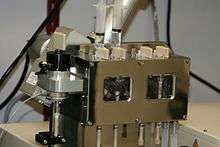Stopped-flow
Stopped-flow is a lab technique for studying fast chemical reactions.

A stopped-flow instrument is a rapid mixing device used to study the chemical kinetics of fast reactions in solution. The solutions are first forced from syringes into a mixing chamber. After perhaps a few milliseconds the observation cell is filled by a piston linked to a sensing switch that triggers the measuring device and the flow is stopped suddenly. The system is often modeled by conventional kinetic equations.
After two or more solutions containing the reagents are mixed, they are studied by whatever experimental methods are deemed suitable. Different forms of spectroscopy and scattering of radiation are common methods used. The dead time is the time between the end of mixing the two solutions and the beginning of observation of the kinetics of the reaction. The usual dead time of a stopped flow apparatus is 1–2 milliseconds but some new devices have been developed that have dead times of 0.3–0.6 ms.[1]
A stopped-flow instrument coupled to either a circular dichroism spectrometer or a fluorescence spectrometer is often used in the field of protein folding, to observe rapid unfolding and/or refolding of proteins.
List of stopped-flow techniques
- SF fluorescence spectroscopy
- SF circular dichroism
- SF absorbance spectroscopy
- SF small-angle scattering[2]
Quenched-flow
In a quenched-flow instrument, the reaction is stopped after a certain amount of time has passed after mixing. The stopping of the reaction is called quenching and it can be achieved by various means, for example by mixing with another solution, which stops the reaction (chemical quenching), quickly lowering the temperature (freeze quenching) or even by exposing the sample to light of a certain wavelength (optical quenching).
See also
- Syringe driver - sometimes used as part of a stopped-flow device.
- Continuous-flow - alternative to stopped flow.
References
- Clark, Charles R. (1997). "A Stopped-Flow Kinetics Experiment for Advanced Undergraduate Laboratories: Formation of Iron(III) Thiocyannate". Journal of Chemical Education. 74 (10): 1214. Bibcode:1997JChEd..74.1214C. doi:10.1021/ed074p1214.
- West, J.M.; Xia, J.; Tsuruta, H.; Wenyue, G.; O'Day, E.M.; Kantrowitz, E.R. (2008). "Time Evolution of the Quaternary Structure of Escherichia coli Aspartate Transcarbamoylase upon Reaction with the Natural Substrates and a Slow, Tight-Binding Inhibitor". Journal of Molecular Biology. 384 (1): 206–218. doi:10.1016/j.jmb.2008.09.022. PMC 2656920. PMID 18823998.
Further reading
- IUPAC, Compendium of Chemical Terminology, 2nd ed. (the "Gold Book") (1997). Online corrected version: (2006–) "stopped flow". doi:10.1351/goldbook.S06033